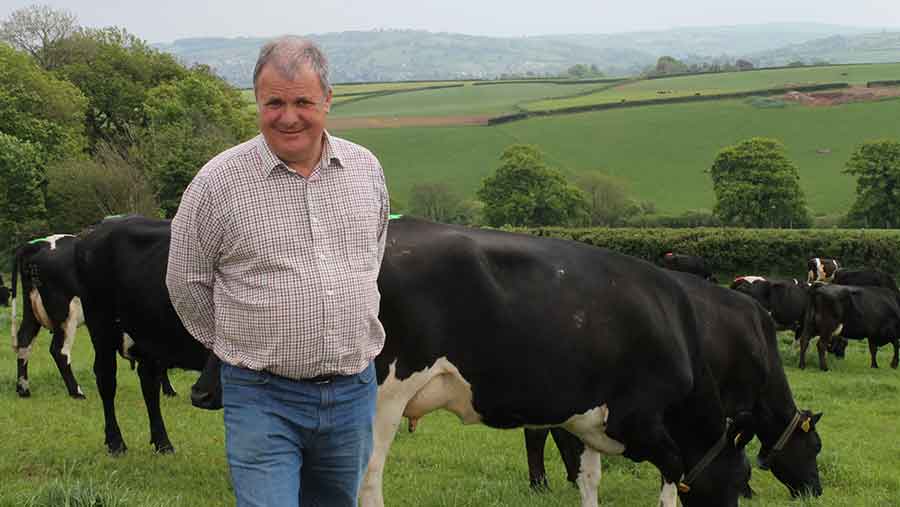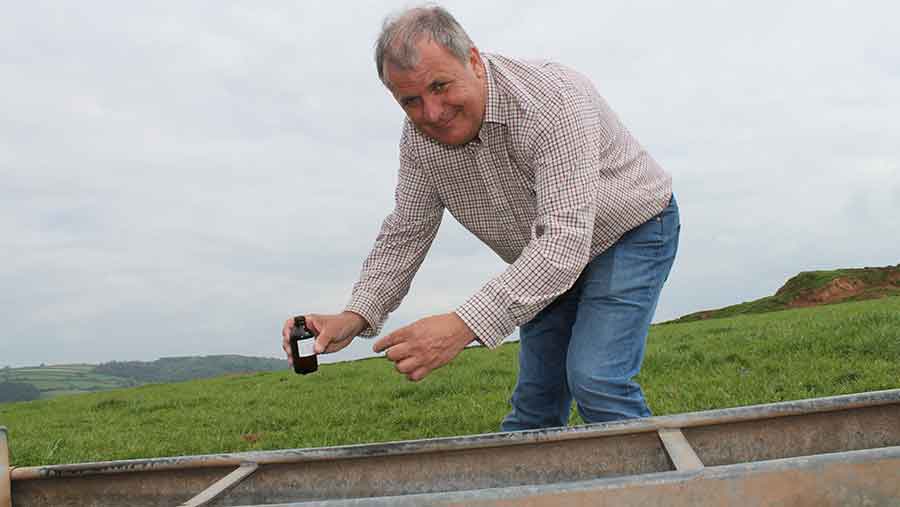How a Devon farmer is using homeopathy to fight bovine TB

Like many farmers in mid Devon, Julian Ayre is under the constant threat of bovine TB.
But he is taking a novel approach to tackling it: A homeopathic remedy.
“We started using the treatment in March 2010, having lost 32 of 80 young heifers in 2008-09,” says Mr Ayre. “I was expecting it to take five years to go clear – in the past when we’ve had a breakdown it has taken that long and we’ve lost 60-70 animals. But we were clear by August 2012.”
However, he gradually got out of the habit of using the remedy, and went down with TB again in December 2014 after purchasing animals from six different sources to stock a second farm.
“We then started treatment immediately. We lost six animals in total: two of which were home-bred with confirmed TB in December 2014 and January 2015. But we were clear by March 2016 – it was great to go clear again so quickly.
How it is administered and the benefits
Mr Ayre puts a few drops of the liquid remedy into the cows’ water trough once a month, and also uses other homeopathic remedies to protect against BVD, leptospirosis, warts and mastitis.
“We first started using homeopathic remedies years ago when a relief milker recommended them for teat warts on the heifers,” he says. “It really seemed to help. We then had a bad bout of scouring which we reckoned was BVD and it stopped after using the treatment.”

© Olivia Cooper
Mr Ayre is the third generation of his family to farm at Stanterton Farm, Washfield, and about 20 years ago switched to an extended grazing system.
He share farms with his son James at the home farm, milking 340 cross-bred cows, and recently set up a share farm with his daughter Jasmine and son-in-law Mike nearby, milking 240 cows on the same system.
See also: Homeopathic treatments under attack from vet
“Our cell counts have gone up, having bought in some older cows for the expansion, so we’re using homeopathy for the whole herd in conjunction with veterinary antibiotic treatments for individual cows,” he says.
The cows calve from February to April, with heifers calving at two years old.
“We have a contract rearer nearby as we don’t have enough housing,” explains Mr Ayre. “There are also quite a few badgers around the farm so we have very little control over TB; our next-door farmer has been down with it very badly for years.”
One of the biggest frustrations of being under TB restriction is the impact on the business, he adds.
“We had to slaughter most of our bull calves and even some heifers as we didn’t have space to keep them or a market to sell them to. But the biggest relief of going clear was being able to split the herds – we calved everything here last year as we were building a new parlour at the other farm. I thought it was going to take years to go clear.”
How does the homeopathic remedy work?
According to Tony Pinkus, joint managing director of Ainsworths, the theory behind homeopathy is to use a natural substance that produces similar symptoms to the disease you’re trying to tackle.
This encourages the body to cure itself, rather than suppressing the symptoms with conventional drugs.
The Greek origin of the word is “Homoios” – meaning “like” – and “Pathos” – meaning “healing”.
Administering a tiny dose prompts the immune system to respond, helping the body to naturally heal itself.
“We’ve got about 5,000 farmers using homeopathy as it’s cheap, safe and effective, with no milk withdrawal period,” says Mr Pinkus.
“We have a Royal Warrant to supply Prince Charles, who uses the products on his farms – it’s a huge opportunity to safely empower farmers to treat their own animals. There are no side effects or resistance factors, which is a hot topic given antibiotic resistance at the moment.”
In the case of any remedy, it’s all about boosting the cows’ natural healing mechanism.
“The organisms for TB are present all the time – the problem occurs when cows are under more stress, so you want to use a product that nudges the immune system to respond,” says Mr Pinkus.
Absorbed through the membranes in the mouth, it is administered in the water once a day for three days, declining to once a week for three weeks, and then once a month.
“I would suggest not dosing for two weeks before a TB test, to avoid the risk of getting a false positive due to ramping up the immune system.”
Geoff Derges, field agent for Ainsworths, has a number of farmers who’ve been using the remedies for years.
“If it didn’t work, they wouldn’t keep coming back. There are now 120 farmers using the TB remedy regularly, and the first person who bought it from me in 2003 is still using it, which is testament in itself.”
Many vets are sceptical of homeopathy, but all homeopathic vets must first pass the conventional veterinary exams, followed by a further homeopathic qualification, says Geoff Johnson from Wiveliscombe Homeopathic Veterinary Surgery, Somerset.
“Look for the letters VetMFHom to show qualification,” he says. “It’s a hugely in-depth three-year course – we are doubly qualified.”
Mr Johnson started out running a conventional veterinary practice before branching into homeopathy and managing the two alongside each other.
“But I got so busy that I couldn’t advance the homeopathy the way I wanted to, so I sold the conventional practice and now specialise in homeopathy,” he says. “But the two do work together marvellously – that’s what integrated medicine should be.”
Homeopathic treatments in badgers
Typically, Mr Johnson recommends treating acute cases of illness with conventional medicine, supported by homeopathy, and to use homeopathy first for chronic diseases.
Although he has never used homeopathy to prevent TB in cows, he has recommended it to prevent TB in badgers.
“About 20 years ago I wrote to then chief veterinary officer Jim Scudamore recommending he use homeopathic treatments as a third strand of the Krebs Trial, but it didn’t happen,” says Mr Johnson.
“There is a remedy called Tub-bov that is incredibly cheap and easy to use – you’d just give it to the badgers in milk, honey or apple once a week. I’ve known a few farmers who’ve used it to enhance the badgers’ immunity.”
See also: No end in sight to badger TB vaccine shortage
However, taking an holistic approach means drawing together every strand of preventative action, he adds.
“If a farmer wants to try and prevent TB I’d refer them to their conventional vet for advice on keeping badgers away from cows to limit cross-infection.”
He would then add in the homeopathic treatments.
“All farmers know where the setts are on their farm and it would be very easy to leave some treated feed out once a week.”
Critics of homeopathy
However, not everyone is convinced homeopathic remedies work.
Andrew Biggs from Vale Vets, who previously sat on the TB Eradication Group, remains unconvinced about the efficacy of homeopathic prevention of TB.
“I can’t see how it would work,” he says. “Conventional vaccines do have an effect against TB, but show up as a false positive with the current herd TB test.
“If the remedy does induce immunity to the TB bacillus I would also expect it to trigger a positive TB test.”
In TB hotspots herds are always going in and out of TB restriction, adds Mr Biggs.
“If you happen to do something at the right time it might look like it’s worked.”
Healthy animals are always less likely to succumb to disease compared to those already under immune stress, so it is always worthwhile focusing on nutrition and herd health.
“But very high yielding dairy cows are essentially no more prone to TB than beef cows living an easy life. Unfortunately, I have seen some major outbreaks in both dairy and suckler herds.”
However, there are practical options to try and reduce the risk of TB, says Mr Biggs.
“Purchased cattle pose a risk, but then closed herds also go down with TB, so you need to keep contact between badgers and cattle to an absolute minimum.”
Fencing off cattle sheds and feed yards will keep badgers out of buildings, but keeping them completely separate from stock at grass is virtually impossible, he admits.
Options to try and prevent joint access to feed and water include potentially not filling water troughs to the top, and using raised feed troughs with rollers on the side, he adds.
“Of course, if all of these things worked perfectly we wouldn’t be in the position we are in with TB; it’s just about doing as much as you possibly can to minimise the risk.”
